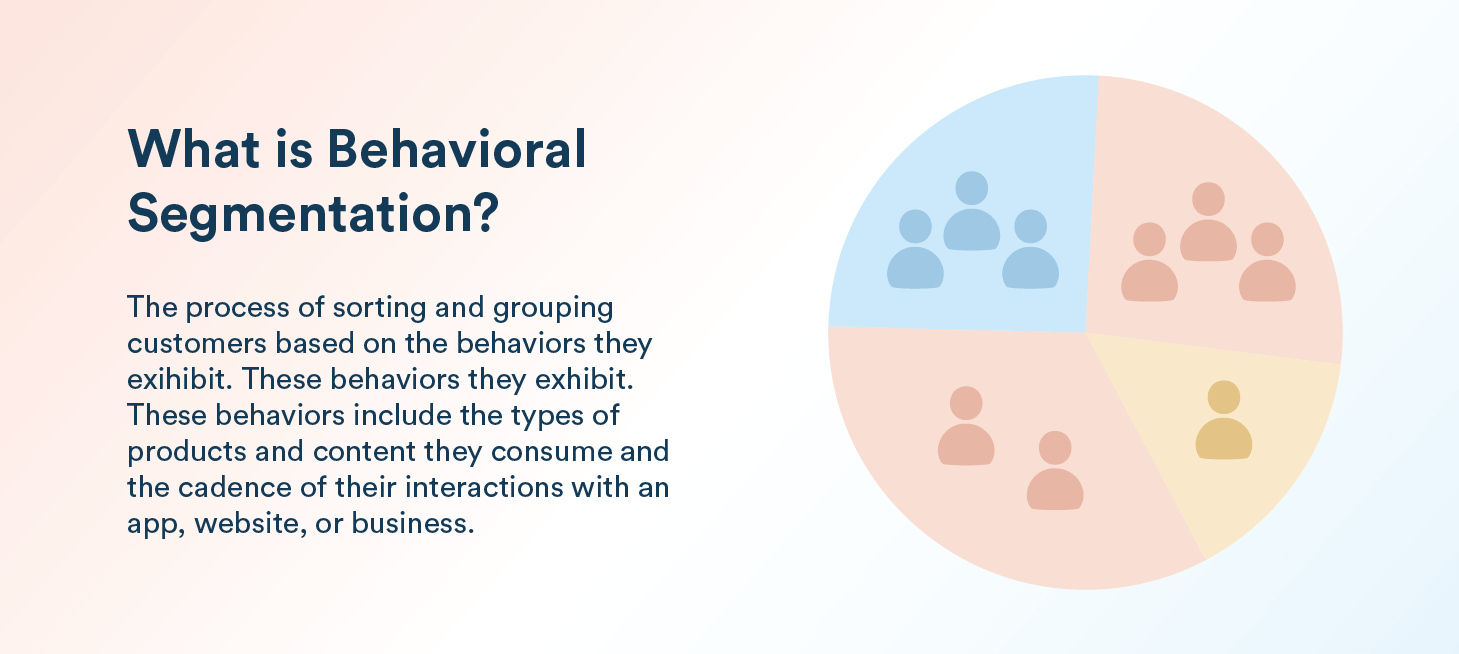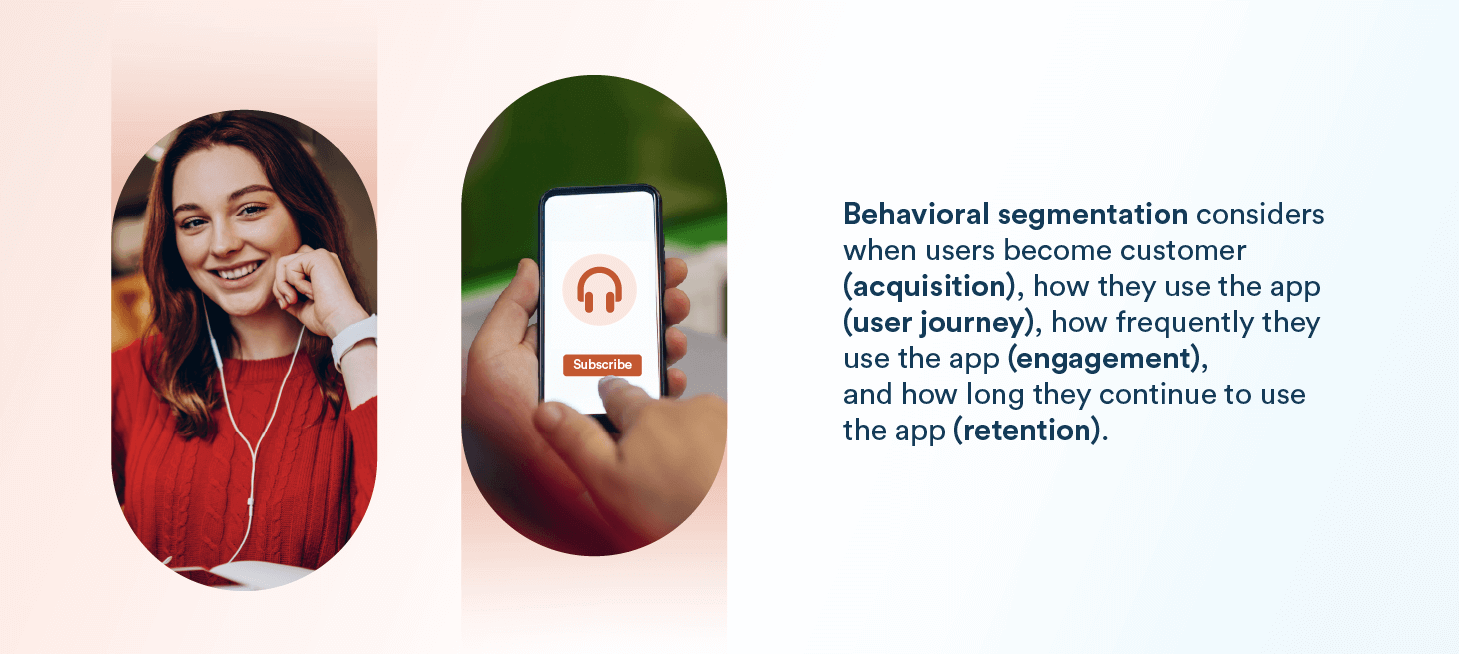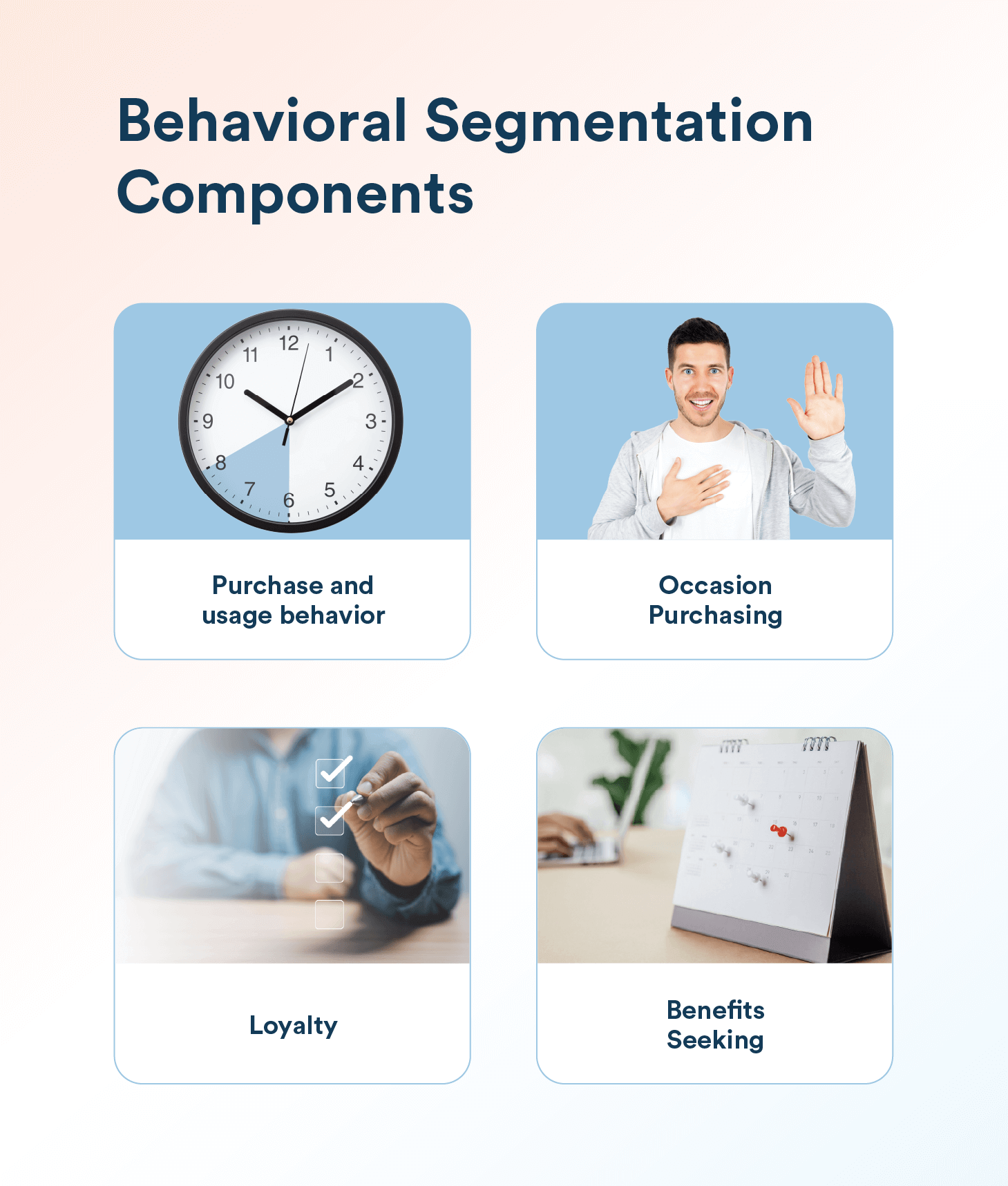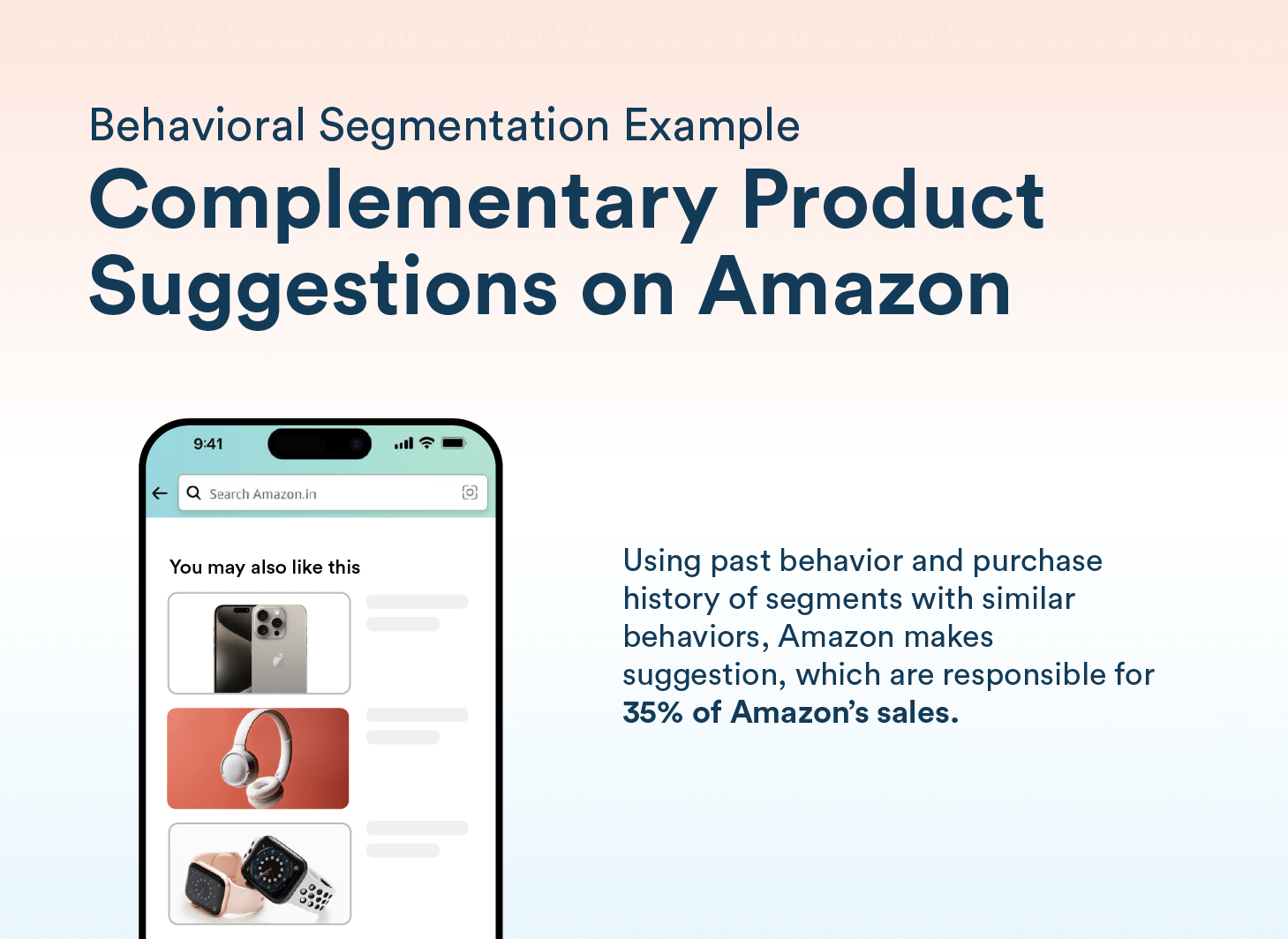Behavioral segmentation is like having a window into your customer’s mind, allowing you to tailor your marketing efforts with pinpoint precision. Learn what behavioral segmentation is and how it can supercharge your marketing efforts.
What is Behavioral Segmentation?

Behavioral segmentation is the process of sorting and grouping customers based on the behaviors they exhibit. These behaviors include the types of products and content they consume, and the cadence of their interactions with an app, website, or business.
Marketers often walk a tightrope separating psychology and business. We often bring our marketing theories of how customers will respond to a marketing campaign. Behavioral segmentation is the observation of each customer’s actions so that marketers can send their tailored messaging.
Case study – Learn how StarQuick enhanced their customer lifecycle with automated segmentation
Once mobile marketers identify users by their specific behavior, they can target messages and campaigns specifically tailored to these audiences.
Why is Behavioral Segmentation Important?
Once mobile marketers identify users by their specific behavior, they can target messages and campaigns specifically tailored to these audiences. The benefits of behavioral segmentation include:
- Personalization: Behavioral segmentation doesn’t just tell you what product or service a certain group of customers likes. It helps you understand what channels they frequent and what type of messaging they respond to so you can boost your conversions.
- Budget allocation: Since you know which segments spend the most and how they spend, you can better allocate your efforts to target them.
- Forecasting: Looking at each segment’s patterns, you can identify trends and more effectively plan for the future.
- Retention: Behavioral segmentation makes customers feel understood and looked after throughout their customer journey. This doesn’t just provide an extraordinary boost to customer satisfaction levels; it also means higher customer lifetime values and long-term revenue.
Behavioral Segmentation Examples
Some of the most common nuances of behavioral segmentation boil down to when users become customers (acquisition), how they use the app (user journey), how frequently they use the product (engagement), and how long they continue to use the product (retention).
In fact, these are all key behavioral segmentation examples that can help you better understand your customers’ needs and preferences. Acquisition, engagement, and retention are all important factors to keep in mind when analyzing customer behavior and selecting behavioral segmentation variables. Understanding the following ways your users can interact with your product will help you accomplish a sustainable and constructive behavioral segmentation strategy.
01. Purchasing and Usage Behavior
Let’s use your ride-sharing app of choice as an example. A working professional uses the service to commute to and from the office Monday through Friday. On weekends, however, the user has the extra time needed to drive, park, and walk to their destination, so they never use the service then.
Understanding this user’s behavior, the ride-sharing service could offer discounts on the weekends to encourage usage on days they normally wouldn’t use the app.
Most companies recognize the power of tracking the purchase, usage, and consumption of their product as a means of forecasting demand. Customer segmentation based on purchase behavior is essential to understanding when your marketing will be most effective.
02. Occasion Purchasing
This component of behavioral segmentation considers the timing within a customer’s life, year, or day as a determinant of purchasing.
Life milestone purchases such as an engagement ring or house; seasonal purchases like holiday decorations and gifts; and daily purchases like coffee or food are all variations of occasion purchasing.
Starbucks uses behavioral segmentation to target their regular morning customers with an incentive to get them back in for another purchase later in the day. Since these regular users will likely have an afternoon coffee on occasion, Starbucks uses email marketing and push notifications within their mobile app to offer happy hour events.
03. Benefits Sought
Other differentiating factors of behavioral segmentation are the benefits different users seek from an experience. Continuing with the Starbucks example, some customers are compelled by the convenience of ordering through the mobile app and their beverage being prepared and paid for when they come in to pick it up.
Other customers are more interested in the experience of ordering with a barista and enjoying the ambiance of a crowded coffee shop. Still, other customers may choose to avoid the barista, order online, and work for hours in the cafe. Understanding the different benefits users seek from the experience with your product or service can help you better serve each segment with that experience.
04. Customer Loyalty
One of the most important behavioral segmentation components is loyalty. Users who exhibit loyal behavior to your business should not be overlooked. Establishing a customer loyalty rewards program is one of the most common methods marketers use to reciprocate loyalty among customers.
A rewards program can be as simple as a “buy 9, get the 10th free” mobile stamp card. For example, Starbucks did just that by recently changing their loyalty program to offer even faster rewards.
To build long-term user retention and loyalty among app users, loyalty should be treated like royalty.
Additional behavioral segmentation considerations include:
- Customer satisfaction
- Engagement level
- User status

In conclusion, using behavioral segmentation examples like purchasing habits and customer loyalty can help you refine your marketing strategy and better serve your audience.
Automate your segmentation with CleverTap today!
Behavioral Segmentation Strategies
Regardless of a user’s behavior, personalization is a strategy that works well. For example, we all have an affinity towards our own names, and if marketers can learn to use this effectively, users are likely to be more receptive. Personalization can be more than just calling people by their names, though.
Your behavioral market segmentation can guide other strategies, including retargeting, targeting complementary products, marketing based on attribution, and even avoiding certain segments.
01. Retarget Desired Behaviors
Past behavior is typically a great indicator of future behavior. Although the past can never perfectly guarantee the future, it can help you make educated assumptions about what’s to come. Much like the basis of economic forecasting, marketers gain valuable insights into behavioral trends based on the consumption of users.
YouTube, for example, has built a sophisticated recommendation engine that can help retarget users with similar videos they will likely find interesting. Not only the content itself but also advertisements users have previously interacted with can help guide future retargeting efforts.
02. Use Location-Based Segmentation
Another strategy is to observe location data to market to users based on their previous, current, or projected location. Geofencing is a great strategy for sending push notifications to app users when they are active in a certain location, such as within a one-mile radius of your business.
Ride-sharing apps use behavioral segmentation of certain neighborhoods to forecast demand and pricing. Urban areas with a late-night bar scene, for example, require more drivers around the time bars close, and prices increase to match the demand.
Ride-sharing apps also use your current location, past behavior, and time of day to predict your final destination. For example, if you are home and open the app on a Monday morning at 8:00 AM, the app might suggest your workplace as a possible destination, simplifying the user experience.
03. Price by Device
Since business is becoming less of a face-to-face experience, marketing has become more reliant on clues to piece together the customer profile puzzle. For example, using device data and understanding how these devices are purchased by different audiences.
Given their hefty price tags, Apple products, for example, are typically purchased by a more affluent customer. PC computers and Android devices are less expensive and, therefore, more widely available to less affluent customers.
Understanding price sensitivity by device has allowed companies like Orbitz to show different price points to different customers based on their device.
04. Suggest Complementary Features or Products
Behavioral segmentation is helpful for building recommendation engines that can accurately predict which products or features each customer may be interested in next.
Amazon uses past behavior and the purchase history of segments with similar behaviors to recommend other products. These product recommendations—a direct result of behavioral segmentation—are responsible for a whopping 35% of sales.
05. Perfect Your Timing
Some users have a regimented schedule, while others are more flexible. Understanding the cadence at which users re-engage with your app can help you know when to send push notifications, email marketing material, or other messages to bring users back.
Analyzing your behavioral segmentation data allows you to optimize the timing of your messaging and might reveal some valuable insights.
Let’s assume your company has localized the app for South America, but after analyzing behavioral segmentation, you realize many users are using the app in the middle of the night. Instead of sending push notifications in the early morning, when your insomnia-prone users are catching up on lost sleep from the night before, you could send push notifications shortly before midnight for the most engagement.
News and media applications deeply contemplate their push notification strategy to reach the right audience at the right time. Some newsrooms argue that the lock screen should be held sacred for breaking news, while others are confident their segmentation strategies will deliver the most engaging content for each particular user.
06. Get Historical
We’ve already mentioned that past behavior is a good indicator of future behavior (okay, a few times now). Although imperfect (disclaimer, check), it can be used to predict the customer journey and allow you to guide users to their end goal faster.
Google Drive is a great example of this with their “Quick Access” dashboard of commonly opened documents. This includes not only recently opened documents but also documents that are commonly opened at the time you open your Drive.
Google also uses historical behavioral segmentation within their smart reply feature to predict the word you will use next in your emails. This tool uses statistical data of the words commonly used in combination with the words previously written to predict the next word or phrase.
These strategies are available to companies like Google and Amazon as well as small and medium-sized enterprises. For companies with the size and scale of Google or Amazon, however, behavioral segmentation becomes a necessity to reach their widespread audiences effectively.
Now that you understand the definition, examples, and strategies, you can start to plan how to use behavioral segmentation within your marketing.
Tips to Implement Behavioral Segmentation
Here are a few ways you can implement behavioral segmentation in your mobile marketing campaigns:
- Remarketing campaigns based on past user behavior
- Send targeted content to user segments based on interests, average order value, frequency of app use, and more.
- Focus your marketing resources on users who are ready to convert.
- Target high-value prospective users by understanding more about who your user base is and how they use your app.
- Time your messaging campaigns for when users are most active and likely to respond favorably.
- Customize messaging and delivery times based on the user’s location, native language, local events, and time zones.
You Might Like to Read: What is Demographic Segmentation? Its Importance, Factors & Examples!
Leverage Technology to Optimize Behavioral Segmentation
Once you’ve laid the groundwork for your behavioral segmentation strategy, the next step is choosing a customer engagement platform that can help you implement it. Clevertap is one of the most comprehensive behavioral segmentation tools you can use to create targeted, personalized marketing campaigns based on real-time data. CleverTap has a host of powerhouse features that can elevate your brand’s behavioral segmentation strategy, including:
- Clever.AI, Clevertap’s proprietary AI, uses sophisticated machine learning algorithms to continuously analyze user behavior, identifying patterns and predicting future actions. This allows businesses to create highly personalized segments. For example, Clever.AI can automatically segment users based on their engagement frequency, recency, and monetary value, allowing brands to target high-value customers with tailored offers and at-risk users with retention campaigns.
- Real-Time Data Processing: The real-time analytics provided by CleverTap ensure that businesses can act quickly on the latest user data. This immediacy is crucial for behavioral segmentation, as it allows brands to respond to user actions as they happen, enhancing engagement and conversion rates. Real-time data processing also means that segments are always up-to-date, reflecting the most current user behaviors and trends.
- TesseractDB: The Tesseract database enhances CleverTap’s ability to store and analyze vast amounts of user data without limitations. This comprehensive data storage allows for deeper behavioral analysis and more accurate segmentation, as brands can access a complete user history and detailed action logs.
Harnessing the power of advanced analytics and AI to better understand and engage your customers can deploy dynamic customer segmentation with laser precision, leading to more effective marketing campaigns. This approach ensures that your messaging is always relevant and timely, enhancing customer satisfaction and driving long-term loyalty.
CleverTap also helps support user segmentation strategies with demographic, geographic, and psychographic segmentation.
Want to increase mobile conversions using behavioral segments?
Behavioral Segmentation for Your Mobile Marketing
Now that you have a firm grasp of behavioral segmentation and how it’s used, you can start optimizing your users based on their behaviors. Understanding that every step of the customer journey is different for each individual customer is an important step for marketers to take.
Sending the right message to the right person at the right time is no simple task. There are a lot of moving parts within your mobile marketing strategy. Behavioral segmentation is one way successful marketers can make each user’s experience feel personalized while still maintaining scale. Here are more ways implementing this segmentation strategy can impact your app’s performance:
- Building knowledge of your customer base and strengthening customer relationships.
- Reducing the cost of mobile marketing and increasing customer lifetime value.
- Analyzing insights to make crucial decisions across all functions of an organization (e.g., product enhancements, CRM, Sales, etc.). In addition, automate processes using a flexible platform that’s quick to deploy.
Implementing behavioral segmentation is like adding a secret ingredient to your marketing recipe. It ensures your messages hit the sweet spot for each customer just when they’re most receptive. With the right tools, you can harness real-time data and AI to fine-tune your outreach, making every interaction feel special. This not only wows your customers, but it dramatically fuels loyalty and long-term growth. So, level up your marketing campaigns with behavioral segmentation and watch your customer relationships flourish!
Learn more about all the segmentation strategies and tools mobile marketers are using to optimize and automate their customer segmentation.
Meet CleverTap at App Promotion Summit in Berlin on 27 November.
Subharun Mukherjee 
Heads Cross-Functional Marketing.Expert in SaaS Product Marketing, CX & GTM strategies.
Free Customer Engagement Guides
Join our newsletter for actionable tips and proven strategies to grow your business and engage your customers.















































